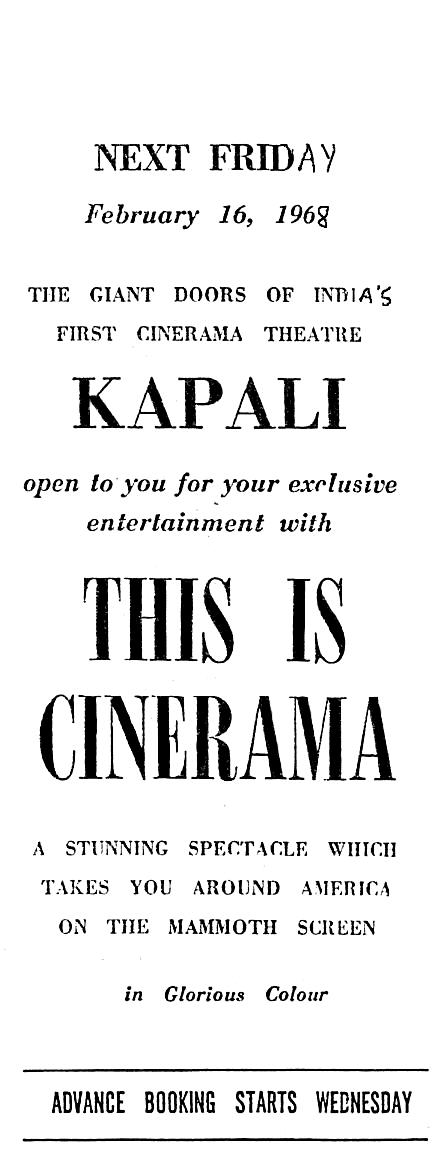Cinerama theatres in India, Pakistan, Sri Lanka
Readers can send additional information, corrections, photographs and even on their online archival encyclopædia only after its formal launch. |
Contents |
Part 3 of 'CinemaScope films in Bangladesh, India, Nepal, Pakistan, Sri Lanka'
Cinerama theatres in India, Pakistan, Sri Lanka

Cinerama was a 3-strip, three-projector technology. Each 35 mm projector ran one third of the image, which was projected on a screen that had a 146° arc, and was much bigger than the 70mm widescreen. How the West Was Won (1962) is the most famous Cinerama feature ever, followed in popularity by an entertaining documentary ‘This is Cinerama’ (1952).
Like Imax after it, 3-Strip Cinerama concentrated on documentary films and only two features were ever made. The other feature, The Wonderful World of the Brothers Grimm (1962)was a biopic.
In 1965 a trial screening of the Cinerama print of How the West Was Won in New Delhi was not successful, with the three projectors not synchronising.
India
Kapali
On 16 February 1968, Bangalore gave India its first Cinerama theatre, Kapali. It had a louvered 84ft by 32ft screen, and 1,500 seats, almost one and a half times as many as at Delhi’s biggest, Shiela. Kapali first screened This is Cinerama and then Seven Wonders of the World.
Pilot
Pilot in Madras was India’s second (and last) Cinerama theatre. Raghavendra recalls [1]: ‘Jason Robards was at his best in the film Ballad of Cable Hogue. It was released in Pilot Theatre, Chennai, which was a craze then, with its Cinerama screen. We virtually felt we were at the location. Though the majority of the audience were fans of western movies, there were some who came for the skin shows. But besides this, it is really a memorable film taking you deep into the subject and made you involve. ..A really nostalgic moment for the likes of the previous generation.’
Later the owners of Pilot fell out. In the case titled Anthony Raj vs. Josephine Sanjeevi, the High Court Of Madras decided on August 02, 2002 [2], inter alia, that ‘the life of the assets shall be computed from the 15th November 1968 the date on which the Pilot Theatre, Madras-14 commenced its commercial exhibition of motion pictures and that on payment of the market value the defendant shall forthwith deliver possession of all the items specified in clause one supra, except the Cinerama equipments together with its screen, films, scaffold, lenses, accessories, etc., more fully described in the schedule 'B' hereunder which shall be removed by the defendant before handing over possession.’
Pakistan
Karachi’s Capri opened five months later, on 26 July 1968, with a 35mm film projected on its 70ft by 30ft Perlux screen. An international register of Cinerama theatres notes that ‘no known Cinerama presentations’ were screened at Capri. [3]
Sri Lanka
The only other Cinerama theatre in South Asia was Colombo’s New Theatre, about which the same authority has no further details. Many countries around the world never constructed a Cinerama theatre, and many just one each.
The cumbersome three-projector Cinerama gave way to single-film 70 mm Cinerama. It's a Mad, Mad, Mad, Mad World (1963), which was filmed in Ultra Panavision 70, was the first of the lot, and a commercial success. A number of successful films were filmed in Ultra Panavision 70, but projected instead on normal widescreens made for 70 mm. Slowly this technology, too, disappeared.
See also
CinemaScope films in Bangladesh, India, Nepal, Pakistan, Sri Lanka
70mm films in India/ South Asia
Cinerama theatres in India, Pakistan, Sri Lanka
